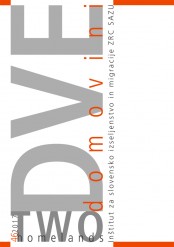Artists’ mobility in the EU: Between Opportunities and Impediments
DOI:
https://doi.org/10.3986/dd.2017.2.05Keywords:
mobility, artists’ mobility, European Union, impediments to mobilityAbstract
Mobility, especially labour mobility, is being promoted and highly praised as an economic and political cornerstone of the European Union, essential for its future development and growth. At the same time, people on the move are faced with many impediments to mobility, artists active in transnational art worlds being particularly vulnerable in this respect. Analysing and comparing various written sources (text and hypertext), the author focuses on the international mobility of artists in and to the European Union. The aim of the article is twofold: to outline artists’ mobility as a particular type of mobility, and to highlight the divergences between praising of the mobility concept on the decision-making level and the ‘naturalization’ of mobility in academic discourse on one side and the critical assessment of artists’ mobility and impediments to it by art practitioners and experts on the other.
Downloads
References
Andor, Laszlo (2014). Labour Mobility in the EU, http://europa.eu/rapid/press-release_SPEECH-14-622_en.htm (11. 1. 2017).
Avcioğlu, Nebahat, Flood, Finbar Barry (2010). Introduction. Globalizing Cultures: Art and Mobility in the Eighteenth Century. Ars Orientalis 39, 7–38.
Barroso, Jose Manuel (2006). 2006 European Year of Worker’s Mobility, http://europa.eu/rapid/press-release_SPEECH-06-109_en.htm (11. 1. 2017).
Bauman, Zygmunt (1998). Globalization: The Human Consequences. New York: Columbia University Press.
Becker, Howard S. (1982). Art Worlds. Berkeley, Los Angeles, London: University of California Press.
Birtchnell, Thomas, Caletrio (2014). Elite Mobilities. Abingdon, New York: Routledge.
Buscher, Monika, Urry, John, Witchger, Katian (2011). Mobile Methods. London, New York: Routledge.
Čoralić, Lovorka, Katalinić, Vjera, Katušić, Maja (2016). Bubnjari, timpanisti, trubači I pifaristi: Glazbena pratnja u mletačkim prekojadranskim kopnenim postrojbama u 18. stoljeću. Arti musices 47/1–2, 27–78.
Di Frederico, Elena, Le Sourd, Marie (2012). Artists’ mobility and visas: A step forward. Final report of On the Move’s workshop on artists’s mobility and Schengen visas. On the Move, www.on-the-move.org (25. 2. 2017).
Duester, Emma (2013). Artist Mobility and the Baltic Cities: Revealing a Transnational Art World. Networking Knowledge 6/4, 107–120.
ECFIN (2015). Quarterly Report on the Euro Area, 14/1, http://ec.europa.eu/economy_finance/publications/qr_euro_area/2015/qrea1_en.htm (20. 1. 2017).
Elliot, Anthony, Urry, John (2010). Mobile Lives. London, New York: Routledge.
ERICarts (2008). Mobility Matters. Programmes and Schemes to Support the Mobility of Artists and Cultural Professionals. Final Report. Bonn: ERICarts.
European Commission (2016). Mobility of Artists and Culture Professionals, http://ec.europa.eu/culture/policy/cultural-creative-industries/mobility_en (1. 2. 2017).
European Commission (2017). Back to Schengen, http://europa.eu/rapid/press-release_IP-17-124_en.htm (1. 6. 2017).
Eur-Lex (2006). European Year of Workers Mobility 2006, http://eur-lex.europa.eu/legal-content/SL/TXT/?uri=URISERV:c11333 (24. 2. 2017).
EUROFOUND (2014). Labour Mobility in the EU: Recent Trends and Policies. Luxembourg: Publications Office of the European Union.
Goldin, Ian, Camron, Geoffrey, Balarajan, Meera (2011). Exceptional People: How Migration Shaped our World and will Define our Future. Princeton, Oxford: Princeton University Press.
Holland, Dawn, Fic, Tatiana, Rincon-Aznar, Ana, Stokes, Lucy, Paluchowski, Pawel (2011). Labour Mobility within the EU: The Impact of Enlargement and the Functioning of the Transitional Arrangements. Final Report, http://www.precarious-work.eu/sites/default/files/effat/files/studies/Labour_mobility_report_July_2011_en.pdf (24. 2. 2017).
IGBK (2010). Challenges for Mobility: Recommendations from the Visual Arts Sector. Berlin. Jaki, Barbara (2010). Predgovor. Robbov vodnjak: Zgodba mestnega simbola (ed. Matej Klemenčič).Ljubljana: Narodna galerija.
Kalčić, Špela, Juntunen, Marko, Rogelja, Nataša (2013). Marginal Mobility: A Heuristic Tool for Comparative Study of Contemporary Mobilities. Dve domovini / Two Homelands 38, 7–20.
Kim, David Young (2014). The Traveling Artist in the Italian Renaissance: Geography, Mobility and Style. New Haven: Yale University Press.
Kiwan, Nadia, Meinhof, Ulrike Hanna (2011). Music and Migration: A Transnational Approach. Music and Arts in Action 3/3, 3–20.
Klemenčič, Matej (2010). Robbov vodnjak: Zgodba mestnega simbola. Ljubljana: Narodna Galerija.
Kobolt, Katja (2008). Art and Migration – the Troubled Relations between the Centre and the Periphery. Living on a Border, KITCH, www.kitch.si/livingonaborder.net/node/41 (11. 1. 2017).
Konjikušić, Davor (2016). Tanja Ostojić: Ne pristajem na cenzuru, Novosti, 24. 8., http://www.portalnovosti.com/tanja-ostojic-ne-pristajem-na-cenzuru (29. 8. 2016).
Mendolicchio, Bashiron Herman (2013). Art and Mobility. An Introduction. Art + mobility, http://artmobility.interartive.org/art-and-mobility-editorial/ (22. 3. 2017).
OMC (2012). Report on Building a Strong Framework for Artists’ Mobility: Five Key Principles, Open Method of Coordination, Working Group of EU Member States’ Experts on Mobility Support Programmes, http://ec.europa.eu/assets/eac/culture/library/reports/artist-mobility-report_en.pdf (22. 4. 2017).
Polaček, Richard (2007). Study on Impediments to Mobility in the EU Live Performance Sector. MOBILE.HOME.
Praznik, Katja (2016). Paradoks neplačanega umetniškega dela: Avtonomija umetnosti, avantgarda in kulturna politika na prehodu v postsocializem. Ljubljana: Sophia.
Pušnik, Tomaž (2014). Mobilna Evropska unija – vzpostavljanje in delovanje oblasti prek mobilnosti. Magistrsko delo. Ljubljana: Univerza v Ljubljani, Fakulteta za družbene vede.
Recommendations on Culture Mobility (2010). From the 4 Arts Mobility Pilot Projects, http://ec.europa.eu/assets/eac/culture/policy/cultural-creative-industries/documents/cultural-mobility_en.pdf (5. 6. 2017).
Salazar, Noel B. (2017). Key Figures of Mobility: An Introduction. Social Anthropology 25/1, 5–12.
Sheller, Mimi (2013). Sociology after the Mobilites Turn. The Routledge Book of Mobilities (eds. Peter Adey, David Bissell, Kevin Hannam, Peter Merriman, Mimi Sheller). London: Routledge, https://www.routledgehandbooks.com/doi/10.4324/9781315857572.ch3#ref4_6.
Sheller, Mimi, Urry, John (2016). Mobilizing the new Mobilities Paradigm. Applied Mobilities 1/1, 10–25.
Thyssen, Marianne (2015). Speech by Commissioner Marianne Thyssen on Europe’s vision for fair labour mobility, http://europa.eu/rapid/press-release_SPEECH-15-6074_en.htm (11. 1. 2017).
Urry, John (2000). Sociology Beyond Societies: Mobilities for the Twenty-first Century. London, New York: Routledge.
Urry, John (2007). Mobilities. Cambridge, Malden: Polity.
Vandenbrande, Tom, Coppin, Laura, van der Hallen, Peter (2006). Mobility in Europe. Analysis of the 2005 Eurobarometer Survey on Geographical and Labour Market Mobility. Dublin: EUROFOUND.
Vishmidt, Marina (2011). Working Artists in the Greater Economy. Motley Crew 1, Autumn, 15–21.
Vujadinovic, Dimitrije (2008). Mobility of Artists and Cultural Professionals in South Eastern Europe. Trans Europe Halles, http://teh.net/resource/cultural-mobility-studies/ (22. 2. 2017).
Downloads
Published
How to Cite
Issue
Section
License

This work is licensed under a Creative Commons Attribution-NonCommercial-NoDerivatives 4.0 International License.
Authors guarantee that the work is their own original creation and does not infringe any statutory or common-law copyright or any proprietary right of any third party. In case of claims by third parties, authors commit their self to defend the interests of the publisher, and shall cover any potential costs.
More in: Submission chapter





